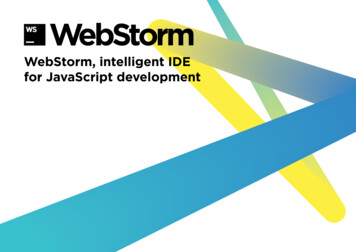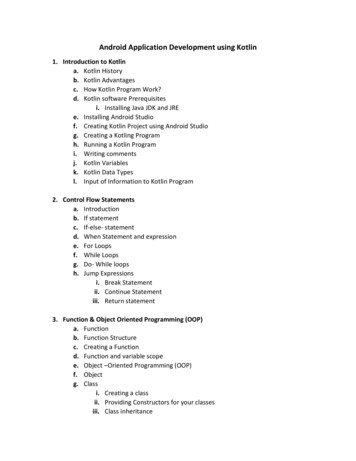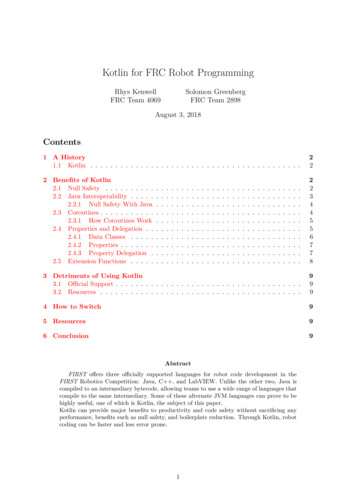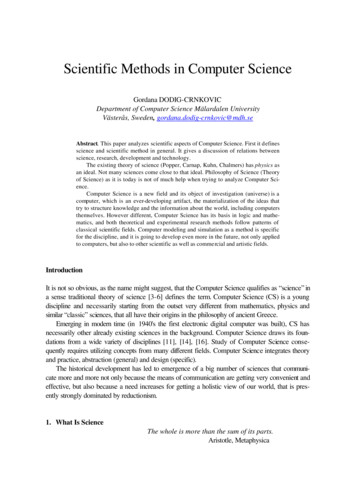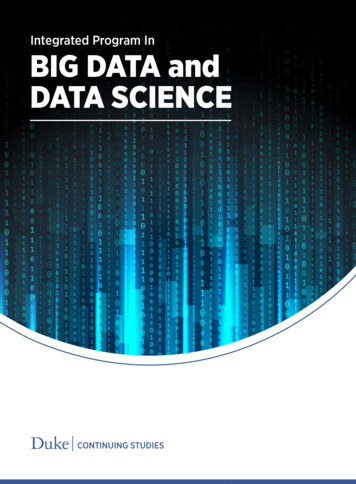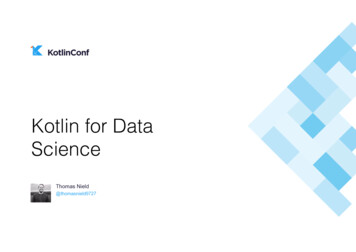
Transcription
Kotlin for DataScience!Thomas Nield@thomasnield9727
AgendaKotlin for Data Science What is Data Science?Challenges in Data ScienceWhy Kotlin for Data Science?Example ApplicationsGetting Involved
Thomas NieldBusiness Consultant at Southwest AirlinesAuthor Getting Started with SQL by O'Reilly Learning RxJava by PacktTrainer and content developer at O’Reilly MediaOSS tisticsRxKotlinFXRxJavaFXRxPy
What is Data Science?A Quick Overview
Not Data Science
What is Data Science?Math/Statistics! Data science attempts to turn data intoinsight. Insight can then be used to aidbusiness decisions or create datadriven products. A strong data science professional hassome mix of programming/hacking,math/statistics, and business domainknowledge.Modeling and !ML!Programming/!Hacking!Analysis andresearch!Data!Engineering!Domain!Knowledge!
Data Science Tooling!SSASPSS! Math/Statistics!MAPL! MATLAB!JR! ulia!Swift!T!.NEModeling and !ML!Scala!PythoAnalysis andl!eresearch! Excn!Programming/! Spark! Data!SQL!Hacking!Engineering!Web/MobDesktop ile/Apps!C/C !Java!Knime!Hadoop!Kafka!Alteryx! PrewoP
Data Scientist ArchetypesA Subjective CategorizationThe Statistician – Summarizes data using classic statistical methods and probabilitymetrics.The Mathematician – The individual who solves a problem by converting it into seaof numbers, often in the form of vectors and matrices.The Data Engineer – An architect of “big data” solutions who can create reusablepipelines of data transformations and share it through reusable API’s.
Data Scientist ArchetypesA Subjective CategorizationThe ML Scientist – A more advanced mathematician who leverages machinelearning, neural networks, and other forms of AI modeling.The Programmer – A trained software developer who likely knows Scala, Java, orPython, and often creates code from scratch tailored to specific business problems.The Bard – The person who crafts communications about data findings with leadersand stakeholders, often telling stories with memos, charts, PowerPoints, infographics,spreadsheets, and other visual tools.
What is a Model?Concoction of Math and CodeWhat is a model? – A code representation of a problem, often mathematical innature, that offers a solution in some form.Examples of models: A linear programming system that finds optimal values for business decisionvariables. Machine learning model that clusters customers based on their attributes. AI that parses, interprets, and links legal documents. Neural network that identifies or categorizes images or natural language.
Data ScienceChallenges
Data Science ChallengesModels Are Not ProductsA current struggle in data science is putting models into production. A model is often a hacky Python or R script that simply does not plug into alarge enterprise technology ecosystem (which is often built on Java or .NET). Models often use dynamically typed languages with tabular data structuresand procedural code which is difficult to modularize, test, evolve, andrefactor. If a model starts to break down and produce errors, it can bring into questionthe data scientist’s credibility.
Data Science ChallengesModels Are Not ProductsModels often need to be rewritten from scratch as software: Software engineers often need to rewrite a model from Python or R to Java. The model needs to be “opened up” so its inner workings can be presented infrontend software. The engineer may even have to introduce production data to the model, as themodel may only have been tested with dummy data. The production code also needs to be architected for scalability, refactorability,code reuse, and testing.
Twitter“There was only one problem — all of my work was done in my localmachine in R. People appreciate my efforts but they don’t know how toconsume my model because it was not “productionized” and theinfrastructure cannot talk to my local model. Hard lesson learned!”!- Robert Chang, Data Scientist at Airbnb (formerly Twitter)!SOURCE: a-data-scientist-at-twitter-f0c13298aee6
Stitch Fix“Data scientists are often frustrated that engineers are slow to put theirideas into production and that work cycles, road maps, and motivations arenot aligned. By the time version 1 of their ideas are put into [production],they already have versions 2 and 3 queued up. Their frustration iscompletely justified.”!- Jeff Magnusson, Director of Data at Stitch Fix !SOURCE: /engineers-shouldnt-write-etl/
Slack“The infinite loop of sadness.”- Josh Wills, Director of Data EngineeringSOURCE: 7808
Recommended ReadingData Science gophers!
Why Kotlin for DataScience?
What is the SolutionKotlin, of course!Data scientists who code often need the following: Rapid turnaround, quick iterative development Easy to learn, flexible code language Mathematical and machine learning librariesExperienced software engineers often want the following: Static typing and object-oriented programming Production-grade architecture and support Refactorability, reusability, concurrency, and scalingKotlin encompasses all the qualities above, and can provide a common platformto close the gap between data science, data engineering, and softwareengineering.
One language, One Codebase, One PlatformData EngineerSoftware Engineering/Dev OpsData Scientist
Kotlin vs PythonStatic vs DynamicPython is a powerful, flexible platform with a simple syntax and richecosystem of libraries.Dynamic typing makes Python flexible for ad hoc analysis, but it ischallenging to use in production. Dynamic types allow improvised data structures to be defined at runtime. ! Dynamic typing can quickly create difficulties in maintaining, testing, anddebugging codebases, especially as the codebase grows large. !
Kotlin vs PythonStatic vs DynamicKotlin, like Scala, embraces immutability and static typing. Data structures are explicitly defined and enforced at compile time, notruntime. ! While static typing is traditionally verbose, Kotlin manages to make itconcise in a Pythonic manner.!Kotlin may not have as many mainstream data science libraries likePython, but it has comparable ones in the Java ecosystem:Apache SparkApache HadoopTensorFlowApache KafkaND4JWekaJava-MLKranglDeepLearning4JApache Commons MathKotlin StatisticsKomputationojAlgo!KomaH20EJML
Kotlin vs ScalaPragmatism vs FeaturesScala has seen success in adoption on the data science domain,arguably due to Apache Spark and other “big data” solutions.However, Scala might have some challenges going forward. Apache Spark is being interfaced in other languages like Python and R tomake it accessible. Computation engines and libraries are increasingly moving back to C/C ,and away from JVM. Plethora of features Good or overwhelming?
Kotlin vs ScalaPragmatism vs FeaturesScala not taking significant share from Python may present anopportunity for Kotlin. Kotlin might be able to finish what Scala started, establishing anengineering-grade coding platform for data science. Compared to Scala, Kotlin has easier interoperability with Java. Kotlin encompasses many of the best ideas from Scala, but strives to besimpler in its features and be more accessible (e.g. “Pythonic”). While computation engines are unlikely to be dominated by Kotlinimplementations, Kotlin can be effective in interfacing with them.
Weaknesses of KotlinFor Data SciencePlatform Drawbacks Not Dynamically Typed – Data structures have to be explicitly defined, which can addadditional steps in working with data. Numerical Efficiency – Boxing of numbers might hurt performance without ND4J orother low-level computation libraries.Libraries and Tooling Ad Hoc Analysis – Casually exploring data without a clear objective may be challengingwithout data frame libraries like Krangl. Libraries – Breadth of data science libraries, while decent, does not match Python or R. Documentation – Java libraries use Java (not Kotlin) in their documentation.
Strengths of KotlinFor Data SciencePlatform Strengths Accessibility – Easy to learn and intuitive, few esoteric features. Minimal boilerplate, fast turnaround – “Pythonic” productivity Interoperability with Java – Plugs into enterprise Java ecosystemsLanguage Features Data classes – No more tuples or improvised data structures at runtime. DSL – Create streamlined languages for domain-specific logic. Static Typing – Benefits of OOP and static typing, without the verbosity. Nullable Types – Helpful asset in data wrangling. Function Syntax – Flexible, expressive function features including extensions. Lambdas and Pipelines – Practical functional programming constructs.
Example Applications
Linear ProgrammingA Word ProblemYou have three drivers who charge the following rates: Driver 1: 10 / hr Driver 2: 12 / hr Driver 3: 15 / hrFrom 6:00 to 22:00, schedule one driver at a time to provide coverage, andminimize cost.Each driver must work 4-6 hours a day. Driver 2 cannot work after 11:00.
Stay CalmMath Powerful Apps
Data-Driven AppsEndless PossibilitiesJust the subject of linear programming alone opens up a large domainof apps: Schedule generation (e.g. classrooms, transportation, staff) Operations and resource planning (e.g. construction, factory planning) Blending problems (e.g. financial portfolios, food/drink ingredients)Kotlin makes it easier than ever to make a model a polished product.Kotlin is capable of solving a wide array of problems for many datascience topics.
Getting Involved
Getting InvolvedHelp Bring Kotlin to Data ScienceTo help bring Kotlin into the data science domain, learn the area(s) thatinterest you.Apache Hadoop/SparkMathematical ModelsStatistical ModelsGraphing/visualizationsMachine LearningLinear programmingCreate some data-driven Kotlin projects and share them!OSS LibrariesBlog articlesData miningData wranglingOptimizationApps
Getting InvolvedHelp Bring Kotlin to Data ScienceNever stop researching, learning, and advocating Although it is incredibly difficult to achieve, never stop striving for that “unicorn”status. Keep struggling to learn math, statistics, machine learning, etc and find waysto make what you learn useful. Introduce data-driven features into your apps, and share how you did it. If you work on a data science team, propose using Kotlin as a possible solutionespecially when production needs arise.
Practical AdviceUsing Kotlin for Data ScienceUtilize object-oriented programming, functional programming, and DSL’swhen doing modeling. Rather than working exclusively with matrices, data frames, and piles ofnumbers, use classes and functional pipelines to keep things organized andrefactorable. Avoid getting procedural and have a well-planned domain of classes, functions,and DSL’s to feed numbers and functions into your modeling library.
Excellent YouTube Channel!!ResourcesTo Learn Data ScienceNever rely on oneresource! !
Alteryx Swift! PowerPoint ! Communication ! SAS ! SPSS! Kafka! Scala! C/C ! Memos! Data Science Tooling . The Statistician – Summarizes data using classic statistical methods and probability . Kotlin vs Python Python is a



